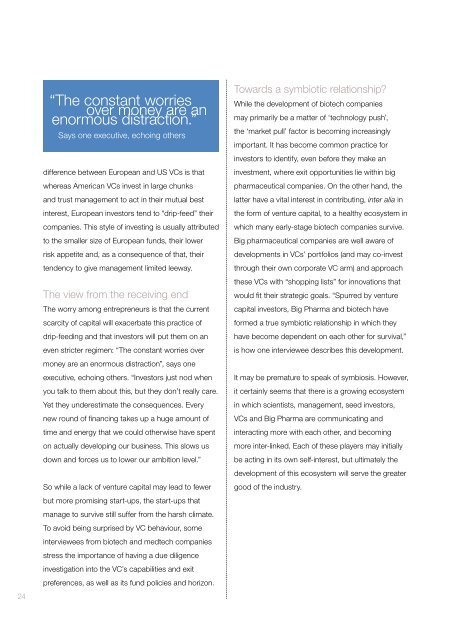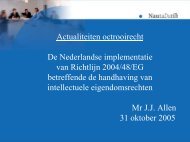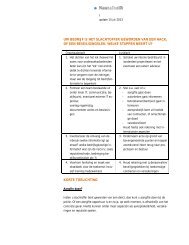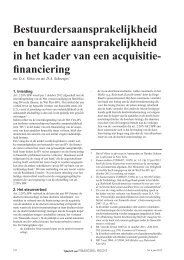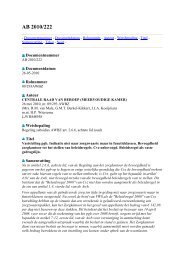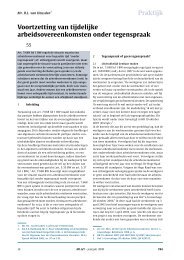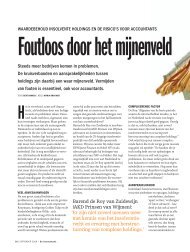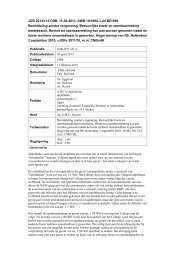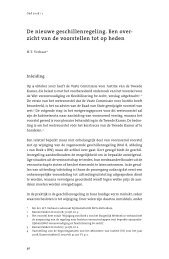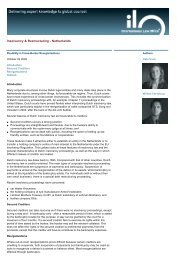Life Sciences Outlook 2012 Dutch biotech companies ... - NautaDutilh
Life Sciences Outlook 2012 Dutch biotech companies ... - NautaDutilh
Life Sciences Outlook 2012 Dutch biotech companies ... - NautaDutilh
You also want an ePaper? Increase the reach of your titles
YUMPU automatically turns print PDFs into web optimized ePapers that Google loves.
“The constant worries<br />
over money are an<br />
enormous distraction.”<br />
Says one executive, echoing others<br />
Towards a symbiotic relationship?<br />
While the development of <strong>biotech</strong> <strong>companies</strong><br />
may primarily be a matter of ‘technology push’,<br />
the ‘market pull’ factor is becoming increasingly<br />
important. It has become common practice for<br />
investors to identify, even before they make an<br />
difference between European and US VCs is that<br />
whereas American VCs invest in large chunks<br />
and trust management to act in their mutual best<br />
interest, European investors tend to “drip-feed” their<br />
<strong>companies</strong>. This style of investing is usually attributed<br />
to the smaller size of European funds, their lower<br />
risk appetite and, as a consequence of that, their<br />
tendency to give management limited leeway.<br />
The view from the receiving end<br />
The worry among entrepreneurs is that the current<br />
scarcity of capital will exacerbate this practice of<br />
drip-feeding and that investors will put them on an<br />
even stricter regimen: “The constant worries over<br />
investment, where exit opportunities lie within big<br />
pharmaceutical <strong>companies</strong>. On the other hand, the<br />
latter have a vital interest in contributing, inter alia in<br />
the form of venture capital, to a healthy ecosystem in<br />
which many early-stage <strong>biotech</strong> <strong>companies</strong> survive.<br />
Big pharmaceutical <strong>companies</strong> are well aware of<br />
developments in VCs’ portfolios (and may co-invest<br />
through their own corporate VC arm) and approach<br />
these VCs with “shopping lists” for innovations that<br />
would fit their strategic goals. “Spurred by venture<br />
capital investors, Big Pharma and <strong>biotech</strong> have<br />
formed a true symbiotic relationship in which they<br />
have become dependent on each other for survival,”<br />
is how one interviewee describes this development.<br />
money are an enormous distraction”, says one<br />
executive, echoing others. “Investors just nod when<br />
you talk to them about this, but they don’t really care.<br />
Yet they underestimate the consequences. Every<br />
new round of financing takes up a huge amount of<br />
time and energy that we could otherwise have spent<br />
on actually developing our business. This slows us<br />
down and forces us to lower our ambition level.”<br />
It may be premature to speak of symbiosis. However,<br />
it certainly seems that there is a growing ecosystem<br />
in which scientists, management, seed investors,<br />
VCs and Big Pharma are communicating and<br />
interacting more with each other, and becoming<br />
more inter-linked. Each of these players may initially<br />
be acting in its own self-interest, but ultimately the<br />
development of this ecosystem will serve the greater<br />
So while a lack of venture capital may lead to fewer<br />
good of the industry.<br />
but more promising start-ups, the start-ups that<br />
manage to survive still suffer from the harsh climate.<br />
To avoid being surprised by VC behaviour, some<br />
interviewees from <strong>biotech</strong> and medtech <strong>companies</strong><br />
stress the importance of having a due diligence<br />
investigation into the VC’s capabilities and exit<br />
preferences, as well as its fund policies and horizon.<br />
24


